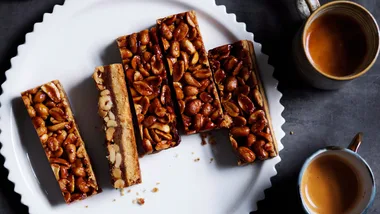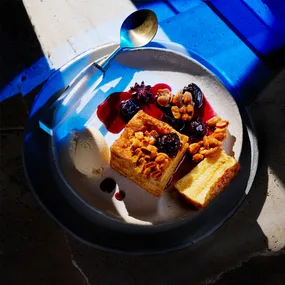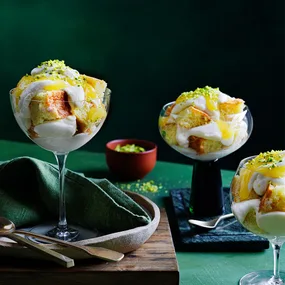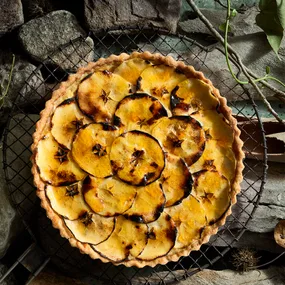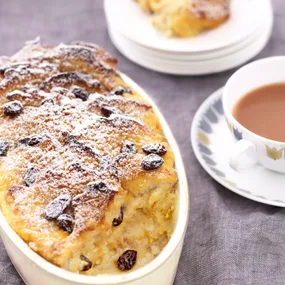I love a chocolate tart that’s rich and luscious with a crisp base and a billowy cream topping. The cream topping isn’t classic, but balances the richness of the dark chocolate, and adds lightness.
The filling, a classic baked ganache, is easy to make, and the sweet shortcrust can be made ahead. I think a chocolate pastry is a bit too intense with a rich chocolate filling; this plain sweet crust adds a textural element that doesn’t overpower the filling.
For the pastry, the butter is rubbed into the flour with your fingertips, then the egg just brings it together. Don’t overwork it or the pastry will be tough and shrink. Flatten it into a disc so it’s easier to roll out, then refrigerate it to rest; this allows it to relax and firm up, which makes it easier to handle when you’re rolling it out.

Step 1.
Dust the bench lightly with flour; if you use too much it will get worked into the dough. Roll the pastry out to a couple of centimetres beyond the diameter of the tin; use the tin as a guide, lifting the pastry up the sides to check. To line the tin, roll the pastry over the rolling pin to lift it and unroll it into the tin, lightly press it into the edges to ensure there are no gaps, then trim the edges. Rest the pastry in the fridge so it relaxes, then prick it with a fork to prevent it puffing up when it’s blind-baked.
The filling for this tart is cooked at a low temperature so we need to blind-bake the pastry case to ensure it’s completely cooked – it won’t continue to cook once the filling goes in the case. For blind-baking, some people use baking paper to line the case; I use foil, spraying the underside to prevent it sticking. For the weights, I use dried chickpeas – they have a nice weight, get right into the corners and don’t stick. Blind-bake the pastry until it’s set in the corners, then remove the weights and foil and bake until it’s cooked through. If necessary, leave in the foil or paper lining while the base cooks completely to prevent the edges getting too dark. I loosely fold the foil over the top of the pastry for this very reason.
You can’t really go wrong with the chocolate filling – a basic ganache with eggs added. I use a bittersweet chocolate with around 70 per cent cocoa solids; I find a lower percentage too sweet. This ganache has a large liquid-to-chocolate ratio, so it won’t split when you combine the two. When you bring the cream and sugar to the boil, let the mixture rise up the sides – this means it’s super-hot throughout and will easily melt the chocolate when it’s poured over it.
Give the bowl a jiggle to disperse the cream evenly through the chocolate, then stir it until it’s smooth – I use a whisk and stir quite briskly from the centre, working outwards, until the mixture is smooth (don’t whisk the mixture; that will create air bubbles that can pit the surface of the tart). Let the chocolate cream cool briefly, then mix a little of it into the eggs to warm them up a bit, then mix in the rest of the cream until the mixture looks shiny.

Step 6.
The filling is baked with just enough heat to set the protein of the egg; the chocolate will set as it cools. If it’s baked at a higher temperature, the outside cooks faster than the centre. The texture of the filling once it’s cooled is luscious, easy to slice, and light to eat. Cool it on the bench or refrigerate it if you’re impatient.
The cream topping is made a few hours ahead and it’s in the fridge ready to go once the tart is cooled. White chocolate adds body and depth of flavour to the cream; you could also use milk chocolate if you prefer. We all know white chocolate is not chocolate, but I like the flavour here. For a different and deeper flavour, caramelise the white chocolate first by placing it in a heatproof bowl in an oven on low heat for a couple of hours.
To melt the white chocolate for this recipe, don’t put it on a saucepan of boiling water; rather, bring the water to the boil, then turn off the heat and sit the bowl on top. If the heat is too high, the chocolate seizes up and becomes grainy. Because you’re adding a lot of cream to it, if it does seize, don’t worry too much – just continue adding the cream and it will loosen up. The white chocolate cream is refrigerated for three hours; it needs to be chilled when it’s whisked, or, again, it will become grainy.
If you serve the tart on the same day you make it, don’t bother refrigerating it, but it’s a great do-ahead dessert. It keeps well in the fridge, minus the white chocolate cream, for a couple of days; take it out of the fridge about 20 minutes before you serve it.
The white chocolate cream goes on at the last minute, and just for extra measure I top it with a sprinkling of grated chocolate for a nice bit of texture. Fancy it up with curls of chocolate if you like, and enjoy it at any time of day, even as a midnight snack – if there’s any left over.

Step 8: Add the white chocolate cream just before serving.
Ingredients
Method
For accuracy, Catherine Adams gives all measurements in grams.
Notes
 Ben Hansen
Ben Hansen
